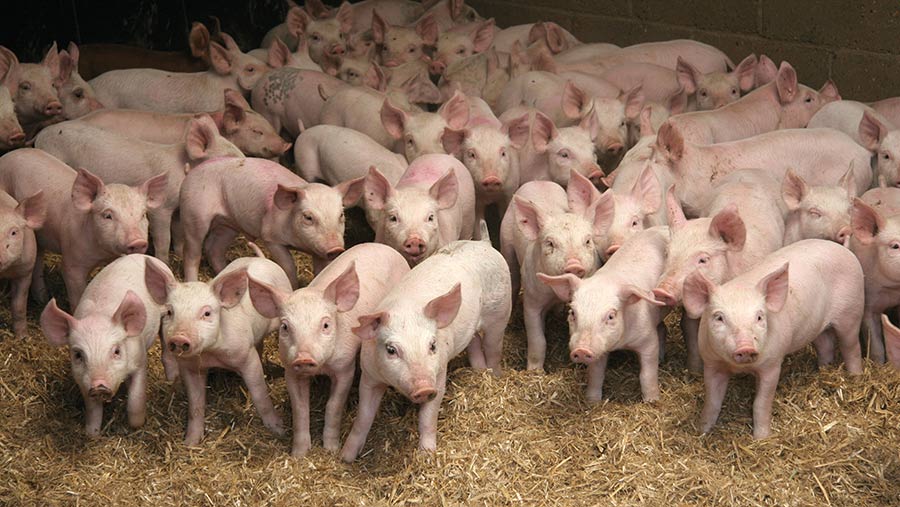Glassers disease in pigs: Signs, treatment and prevention
 © Tim Scrivener
© Tim Scrivener Glassers disease is widespread in UK pig herds, and worldwide. It can cause blood poisoning and death, and is often associated with cases of porcine reproductive and respiratory syndrome (PRRS).
Vet Max Wood, from Larkmead Veterinary Group, offers advice.
See also: How to avoid transmission of the deadly ASF virus to pig herds
Max Wood

Max Wood works for Larkmead Veterinary Group on the farm animal team. He has a special interest in pig medecine and was winner of the Young Farm Vet of the Year at the 2020 National Pig Awards.
What is Glassers?
Glassers is caused by the bacterium heamophilus parasuis. Most pig units will be challenged with the disease to a greater or lesser extent.
Transmission is from pig to pig, via nasal secretions. The incubation period can be as short as 12 hours before septicaemia sets in, and in 36 hours, this will progress to fibrinous polyserositis, polyarthritis and purulent meningitis.
Other diseases affecting pigs at the same time, such as Porcine Reproductive and Respiratory Syndrome (PRRS) or influenza, can trigger outbreaks or worsen the morbidity and mortality on positive farms.
Glassers is also a contributory factor in porcine respiratory disease complex.
Clinical signs
Glassers can strike any age of pig in naïve populations, but recently weaned pigs are the most affected as their maternal immunity wanes.
Outbreaks of the disease see febrile animals become dull and depressed, with a reduced appetite. Shallow, laboured breathing with head extended is common, and nasal discharge is often seen.
The acute disease can simply cause sudden death.
Pigs can become lame with arthritis, and swelling might develop on the face and one or both ears. Skin discoloration to blue or red is common and death generally follows within two to five days.
Chronic arthritis, heart failure associated with pericarditis, meningitis and intestinal obstruction once the fibrinous exudate becomes fibrous are typical of pigs which are chronically infected. Pigs with belly ruptures are at risk of blockage.
Post-mortem examinations reveal fibrin on the lungs (pleurisy), heart (pericarditis), peritoneum and abdominal organs (peritonitis).
Pneumonia may be present, and several other organs may be affected.
Fibrous pericarditis and pleurisy are frequently recorded at meat inspection. Post-mortem lesions are typical and can be very suggestive of Glassers disease, but it is best to get a diagnosis confirmed at a laboratory.
Treatment
Broad-spectrum antibiotics such as amoxicillin generally have a good success rate against Glassers and injectable versions can be used in individual cases.
“Treatment failures” are usually a result of a concurrent disease being present and masking the presence of Glassers.
All-in, all-out weaning systems may also be used to reduce the likelihood of transmission.
In-water or in-feed medication will reduce transmission in the face of an outbreak.
Medication over risk periods can also reduce the impact of the disease, especially when pigs enter a new airspace.
Treatments have varying degrees of success; vaccination and management are the preferred method of control.
Natural immunity develops to the infecting strain and immunity passed from the sow to her piglets may last for four weeks.
Prevention
Heamophilus parasuis does not survive well out of the pig so infected pigs are the main risk factor in introducing Glassers.
The best option is to prevent the ingress of Glassers onto your farm. Good biosecurity and knowledge of source farms are essential to facilitate this.
Commercial vaccines are available to import, but they only provide immunity to serotypes 4 and 5.
While there may be cross-protection against other strains, these serotypes are the two most widespread virulent ones.
Ideally these vaccines should only be used if the serotypes have been identified on farm or in an emergency situation.
Maintaining a stable health status in the herd will reduce issues. Minimising stress at weaning and maximising resilience of the pigs will also help in reducing the disease.
